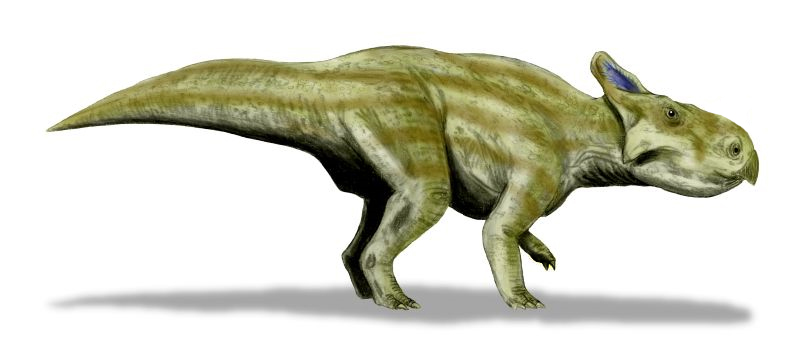|
Akidnognathid
Akidnognathidae is an extinct family of therocephalian therapsids from the Late Permian and Early Triassic of South Africa, Russia and China. The family includes many large-bodied therocephalians that were probably carnivorous, including ''Moschorhinus'' and ''Olivierosuchus''. One akidnognathid, ''Euchambersia'', may even have been venomous. Akidnognathids have robust skulls with a pair of large caniniform teeth in their upper jaws. The family is morphologically intermediate between the more basal therocephalian group Scylacosauridae and the more derived group Baurioidea. Research history The first known fossils of akidnognathids consists of two skulls which were discovered during a series of excavations carried out from 1899 until 1914 by Vladimir Amalitsky and his companion in the Northern Dvina, in present-day European Russia. In an article published posthumously in 1922, Amalitsky established a new taxon of therocephalians under the name ''Anna petri'', in honor of his c ... [...More Info...] [...Related Items...] OR: [Wikipedia] [Google] [Baidu] |
Euchambersia
''Euchambersia'' is an extinction, extinct genus of therocephalian therapsids that lived during the Late Permian in what is now South Africa and China. The genus contains two species. The type species ''E. mirabilis'' was named by paleontologist Robert Broom in 1931 from a skull missing the lower jaw. A second skull, belonging to a probably immature individual, was later described. In 2022, a second species, ''E. liuyudongi'', was named by Jun Liu and Fernando Abdala from a well-preserved skull. It is a member of the family Akidnognathidae, which historically has also been referred by as the synonymous Euchambersiidae (named after ''Euchambersia''). ''Euchambersia'' was a small and short-snouted therocephalian, possessing large canine tooth, canines as is typical of the group. However, it is notable among therocephalians for possessing ridges on its canines and a large indentation in the side of the skull. It has been proposed that these structures supported a venom delivery mech ... [...More Info...] [...Related Items...] OR: [Wikipedia] [Google] [Baidu] |
Moschorhinus
''Moschorhinus'' is an extinct genus of therocephalian synapsid in the family Akidnognathidae with only one species: ''M. kitchingi'', which has been found in the Late Permian to Early Triassic of the South African Karoo Supergroup. It was a large carnivorous therapsid, reaching in total body length with the largest skull comparable to that of a lion in size, and had a broad, blunt snout which bore long, straight canines. ''Moschorhinus'' appears to have ecologically replaced the gorgonopsids as an apex predator, and hunted much like a big cat. While most abundant in the Late Permian, it survived into the Early Triassic in small numbers after the Permian Extinction, though these Triassic survivors had stunted growth. Taxonomy The genus name ''Moschorhinus'' is derived from the Ancient Greek words μόσχος (mos'-khos) ''moschos'' for calf or young animal, and ''rhin/rhino-'' for nose or snout, in reference to its short, broad snout. The species name, ''kitchingi'', refers t ... [...More Info...] [...Related Items...] OR: [Wikipedia] [Google] [Baidu] |
Olivierosuchus
''Olivierosuchus'' is an extinct genus of therocephalian therapsids. It is a member of the family Akidnognathidae. Fossils of ''Olivierosuchus'' have been found from the Early Triassic ''Lystrosaurus'' Assemblage Zone in South Africa. Unlike other akidnognathids such as '' Moschorhinus'', it has a narrow snout and fewer postcanine teeth. As a distinguishing feature, ''Olivierosuchus'' also has a sharp ridge near the choana, an opening in the skull palate. Bumps and projections cover the pterygoid, a bone that forms part of the palate. ''Olivierosuchus'' was a top predator of the lower ''Lystrosaurus'' Assemblage Zone (LAZ) and lived alongside other large therapsids like ''Moschorhinus''. The high diversity of akidnognathids in the LAZ suggests that the group recovered quickly from the Permian-Triassic extinction event, a mass extinction in which many other therapsid groups disappeared. A burrow cast described in 2010 from the LAZ has been attributed to ''Olivierosuchus'' or ... [...More Info...] [...Related Items...] OR: [Wikipedia] [Google] [Baidu] |
Shiguaignathus
''Shiguaignathus'' is an extinct genus of therocephalian therapsid that lived in what is now China during the Late Permian. It was found in the Naobaogou Formation The Naobaogou Formation is a geological formation in the Daqing Mountains of China. It is likely of Lopingian (Late Permian) age. It consists of three rhythms of sediment, labeled members I-III primarily of purple siltstone, but each with a thick ... and is known from a partial skull. It was found to be a basal member of Akidnognathidae. See also * List of synapsids References Akidnognathidae Therocephalia genera Fossil taxa described in 2017 {{Paleo-therapsid-stub ... [...More Info...] [...Related Items...] OR: [Wikipedia] [Google] [Baidu] |
Jiufengia Jiai
''Jiufengia'' is an extinct genus of therocephalian in the family Akidnognathidae. It is known from a single species, ''Jiufengia jiai'', from the Late Permian Naobaogou Formation in China China, officially the People's Republic of China (PRC), is a country in East Asia. With population of China, a population exceeding 1.4 billion, it is the list of countries by population (United Nations), second-most populous country after .... References {{Taxonbar, from=Q96694289 Therocephalia genera Akidnognathidae Eutherocephalia ... [...More Info...] [...Related Items...] OR: [Wikipedia] [Google] [Baidu] |
Promoschorhynchus
''Promoschorhynchus'' is a genus of akidnognathid therocephalians from the Late Permian and Early Triassic of South Africa South Africa, officially the Republic of South Africa (RSA), is the Southern Africa, southernmost country in Africa. Its Provinces of South Africa, nine provinces are bounded to the south by of coastline that stretches along the Atlantic O .... Unlike many other therapsids, ''Promoschorhynchus'' survived the Permian-Triassic extinction event. References Akidnognathidae Therocephalia genera Lopingian synapsids of Africa Fossil taxa described in 1954 Lopingian genus first appearances Changhsingian genera Induan genera Early Triassic genus extinctions {{paleo-therapsid-stub ... [...More Info...] [...Related Items...] OR: [Wikipedia] [Google] [Baidu] |
James Kitching
James William Kitching (6 February 1922 – 24 December 2003) was a South African vertebrate palaeontologist and regarded as one of the world’s greatest fossil finders. Career His work in the southern hemisphere, including Antarctica, led to the establishment of one of the world's finest fossil collections, housed at the Bernard Price Institute for Palaeontological Research (BPI) in Johannesburg.University of the Witwatersrand, Johannesburg, Bernard Price Institute He contributed greatly to the Karoo palaeontology of southern |
1951 In Paleontology
Archosaurs Newly named dinosaurs Data courtesy of George Olshevsky's dinosaur genera list. Synapsids Non-mammalian References {{portal, Paleontology 1950s in paleontology Paleontology 1 ... [...More Info...] [...Related Items...] OR: [Wikipedia] [Google] [Baidu] |
Annatherapsidus
''Annatherapsidus'' is an extinct genus of therocephalians from the Upper Permian of Russia. It was a fairly small animal with a length of 91 cm and a 22 cm skull. It was originally named ''Anna petri'', but the genus name was already taken, so it was renamed to ''Annatherapsidus''. See also * List of therapsids This list of therapsids is an attempt to create a comprehensive listing of all Genus, genera that have ever been included in the Therapsida excluding mammals and purely vernacular terms. The list includes all commonly accepted genera, but also gene ... References Prehistoric synapsids of Europe Akidnognathidae Fossil taxa described in 1961 Taxa named by Oskar Kuhn Therocephalia genera {{paleo-therapsid-stub ... [...More Info...] [...Related Items...] OR: [Wikipedia] [Google] [Baidu] |
1963 In Paleontology
Events January * January 1 – Bogle–Chandler case: Commonwealth Scientific and Industrial Research Organisation scientist Dr. Gilbert Bogle and Mrs. Margaret Chandler are found dead (presumed poisoned), in bushland near the Lane Cove River, Sydney, Australia. * January 2 – Vietnam War – Battle of Ap Bac: The Viet Cong win their first major victory. * January 9 – A January 1963 lunar eclipse, total penumbral lunar eclipse is visible in the Americas, Europe, Africa and Asia, and is the 56th lunar eclipse of Lunar Saros 114. Gamma has a value of −1.01282. It occurs on the night between Wednesday, January 9 and Thursday, January 10, 1963. * January 13 – 1963 Togolese coup d'état: A military coup in Togo results in the installation of coup leader Emmanuel Bodjollé as president. * January 17 – A last quarter moon occurs between the January 1963 lunar eclipse, penumbral lunar eclipse and the Solar eclipse of January 25, 1963, annular solar ... [...More Info...] [...Related Items...] OR: [Wikipedia] [Google] [Baidu] |
Oskar Kuhn
Oskar Kuhn (7 March 1908, Munich – 1 May 1990) was a German palaeontologist. Life and career Kuhn was educated in Dinkelsbühl and Bamberg and then studied natural science, specialising in geology and paleontology, at the University of Munich, from which he received his D. Phil. in 1932. He worked in the University of Munich Geological Institute, among other things on the ''Fossilium Catalogus'' (Catalogue of Fossils), and then in 1938 on a stipend from the Deutsche Forschungsgemeinschaft, moved to the University of Halle, where he worked on the Geiseltal fossils. In 1939 he achieved his Habilitation with a thesis on the Halberstadt Keuper fauna, and in 1940 was named Privatdozent in geology and paleontology. Informed by his Catholic religion, Kuhn was an exponent of idealistic morphology: he viewed evolution as operating only within predetermined morphological classes. In 1943 he declared, "The theory of descent has collapsed." After a political conflict with his mentor ... [...More Info...] [...Related Items...] OR: [Wikipedia] [Google] [Baidu] |
1940 In Paleontology
Plants Angiosperms Arthropods insects Archosauromorphs Crurotarsans Dinosaurs Data from George Olshevky's dinosaur genera list. Plesiosaurs New taxa Synapsids Non-mammalian References {{Reflist 1940s in paleontology 1940 in science, Paleontology 0 ... [...More Info...] [...Related Items...] OR: [Wikipedia] [Google] [Baidu] |






